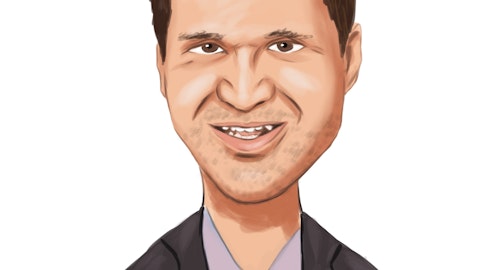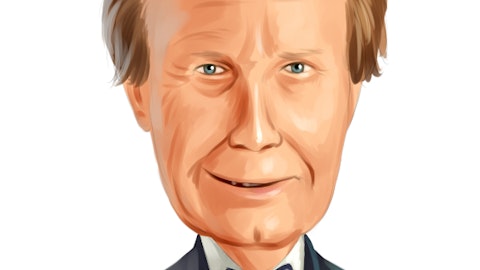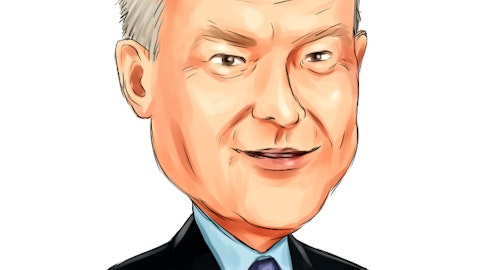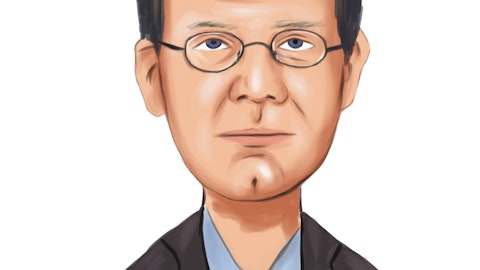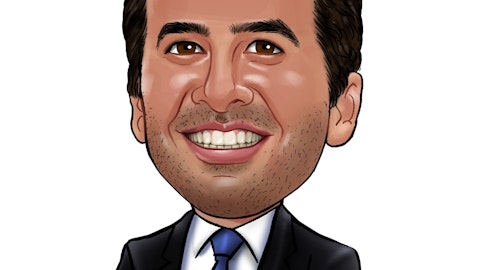Triumph Group, Inc. (NYSE:TGI) Q3 2023 Earnings Call Transcript February 1, 2023
Operator: Welcome to Triumph’s Third Quarter Fiscal Year 2023 Results Conference Call. This call is being carried live on the Internet. There is also a slide presentation included with the audio portion of the webcast. Please ensure that your pop-up blocker is disabled if you are having trouble viewing the slide presentation. All participants will be in listen-only mode. Please note this event is being recorded. In addition, please note that this call is the property of Triumph Group, Inc. and may not be recorded, transcribed or rebroadcast without explicit written approval. I would now like to introduce Tom Quigley, Triumph’s Vice President of Investor Relations, Mergers and Acquisitions and Treasurer, who will provide a brief opening statement.
Tom Quigley: Thank you. Good morning, and welcome to our third quarter fiscal 2023 earnings call. Today, I’m joined by Dan Crowley, the company’s Chairman, President and Chief Executive Officer; and Jim McCabe, Senior Vice President and Chief Financial Officer of Triumph. As we review the financial results for the quarter, please refer to the presentation posted on our website this morning. We will be discussing our adjusted results. Our adjustments in any reconciliation of non-GAAP financial measures to comparable GAAP measures are explained in the earnings press release and in the presentation. Certain statements on this call constitute forward-looking statements within the meaning of the Private Securities Litigation Reform Act of 1995.
These forward-looking statements involve known and unknown risks, uncertainties and other factors, which may cause Triumph’s actual results, performance or achievements to be materially different from any expected future results, performance or achievements expressed or implied in the forward-looking statements. Dan, I’ll turn it over to you.
Dan Crowley: Thanks, Tom. For the quarter Triumph delivered strong sales in our operations that were up both sequentially and over the prior year. We grew our backlog at double-digit rates. On our last earnings call, I discussed the supply chain constraints delaying deliveries in our second quarter, mostly impacting our defense programs. Intensive management of our supply chain enabled us to improve supplier on time and full deliveries from 77% to 87%, reducing the impact of these headwinds on Triumph. This enabled our defense sales to improve 5% sequentially up to $112 million. We anticipate the pickup in commercial volume we saw this quarter, particularly in the aftermarket will continue to improve. We forecast our Q4 top line and profitability to be materially higher sequentially and year-over-year as OEM and MRO deliveries accelerate.
Accordingly, we are increasing our revenue and our full-year adjusted EPS guidance. As we committed, we also remain on track to be cash positive in the second half of the year and in fiscal 24. Overall, I’m pleased that we delivered our Q3 results in line with or above our expectations, positioning us well for Q4. I want to thank our employees. Like many others, we’ve experienced a few years of volatility. Internally, Triumph leveraged our experience from the pandemic to create a new deal, a new social contract and value proposition for employees, who work at our company for more than a paycheck. Extending the empowerment and flexible work environments, which helped us get through the pandemic. Now on slide three, I’ll summarize the quarter’s highlights.
First, we generated organic sales growth of 21% quarter-over-quarter and 13% year-over-year, driven by improving commercial OEM and MRO demand. Triumph’s exit of the legacy structures business was done at less than half of the budgeted costs. Q3 margins stepped up returning to prior year levels and are expected to increase in Q4 with year-end shipments. Backlog is up 12% as Triumph and our customers benefit from our diverse platforms and end markets. Beyond higher MRO receipts and OEM rates, new wins in the space market and for products supporting the war in Ukraine contribute to our goal to generate 25% of our sales from new products and markets. With a pipeline of over $9 billion in opportunities, strategic wins on new platforms and increasing R&D expenditures on differentiating technologies.
We anticipate strong revenue increases over our planning horizon of fiscal 24 to ’28. Turning to Q4, we expect strong positive free cash flow made possible by material reductions in past due backlog, inventory and working capital. We have high confidence in our Q4 and year-end outlook for several reasons. Triumph entered Q4 with higher levels of inventory as a result of deferred demand on certain programs and substantially all orders to be delivered in Q4 are now in hand. Legacy commercial aircraft MRO demand has increased as older aircraft remain in service pending new aircraft deliveries from Boeing and Airbus. Military MRO orders, which were seasonally delayed with the October end of the government’s fiscal year are now funded. Military customers supporting the war in Ukraine and replenishment of U.S. inventories have requested quick turn and/or early deliveries with favorable cash terms.
We completed a thorough review of all of our supply chain requirements for planned deliveries and have sufficient parts on hand or in transit to support planned deliveries. And supplier shortages are improving as we resource and dual source work to domestic and low-cost sources. So overall, we feel good about the quarter and the ramp is upon us. We saw month-over-month improvement during Q3, which we expect to benefit Q4 and our fiscal ’24 forecast as we increase cash flow from operations year-over-year. Consistent with our track record, we’re not standing still. Against a stronger and more promising operating environment, we’ve been turning our attention to strengthening our balance sheet and addressing near-term maturities, which is one of our top priorities.
We have a comprehensive deleveraging plan that builds on our operational improvement. As one component of this plan, Triumph announced distribution of warrants in December. When the warrants are exercised, the benefits of this action are anticipated to be two-fold. It will lower our debt, while increasing equity for the benefit of our investors through a cost efficient transaction. We distributed the warrants given our confidence in our business results and growth outlook. The warrants are one lever we’re pulling as we prepare to refinance our upcoming 2024 debt maturities with the assistance of outside financial advisors. Of course, timing is an important consideration. Our team has been agile in our refinancing approaches, which allowed us to bridge through the pandemic and market downturn.
We are confident in our ability to secure the financing we need to fund our growth in that of our customers. Our improving results also support expanded reinvestment in CapEx and IRAD and enhance the value we deliver to all stakeholders. We’re always looking at ways to manage cost in support of our future state. As we exit our structures business and retire IRAD programs, we are targeting reductions in overhead and SG&A. This enables continued margin expansion as our strong backlog growth translates into higher sales year-over-year. We are confident in the proactive steps we’re taking to even better position Triumph for the future. Jim will now take us through our third quarter results and detailed outlook and then I’ll provide some comments on the market.
Jim?
Jim McCabe: Thanks, Dan, and good morning, everyone. I’m pleased to report year-over-year profitable growth this quarter. Triumph’s third quarter results met or exceeded our expectations and we are on track to achieve our full-year financial objectives. Our consolidated results for the quarter are on slide four. Revenue of $329 million reflects increasing demand from our commercial, military and MRO customers. Excluding revenue from divested businesses and sunsetting programs, we grew consolidated revenue 21% organically over the prior year quarter. Adjusted operating income for the quarter was $36 million, representing an 11% margin, which is up over the prior year. Systems and support segment results and highlights are on slide five.
Organic revenue was up 21% in the quarter. Commercial market demand was the largest driver of the revenue growth in this segment, especially commercial MRO demand. More details on revenue by end market will be in our 10-Q. System and supports operating income was $43 million or 15% margin in the quarter. This is up from the prior year, excluding a licensing transaction and the benefit from the aviation manufacturing job protection act last year. The results from our Structures segment are on slide six. The continuing business in this segment is the interiors, insulation and ducting business. Excluding divestitures and sunsetting programs, revenue of $44 million was up 21% organically. Increasing production rates on the 737 and 787 programs in interiors are driving the strong organic growth.
Operating income improved over the prior year on the higher revenue. Our free cash flow walk is on slide seven. Our $5 million of cash used this quarter included about $11 million of working capital growth supporting the planned ramp in Q4 deliveries. In Q4, we expect working capital to contribute to free cash flow as inventory and accounts receivable decrease from higher Q4 shipments and cash collections. We expect strong free cash flow in Q4, in line with our new full-year guidance. We expect capital expenditures to be approximately $25 million for the year and substantially all of that capital is investment in our Systems and Support segment. The schedule of our net debt and liquidity is on slide eight. At the end of the quarter, we had $1.5 billion of net debt.
We had about $127 million of cash and availability, which is more than sufficient for our projected needs. We expect to be profitable and cash positive in Q4 consistent with our new full-year guidance. We’re continuing to reduce our leverage as planned by expanding EBITDA and free cash flow in our continuing businesses. Dan and I remain confident in our ability to reduce our leverage, improve our capital structure and address our debt maturities with a series of timely and thoughtful actions. In December, we took one of those actions when we distributed warrants pro rata to Triumph shareholders. The warrants give Triumph shareholders a valuable security and the choice of how to realize that value. Warrants that are exercised will help reduce Triumph’s leverage, reduce debt and interest expense and increased free cash flow and liquidity.
Regarding refinancing of our 2024 maturities, we remain opportunistic and continue to pay close attention to the improving capital markets. We see the window of opportunity opening and we look forward to reporting progress in this area in the coming months. For our full-year guidance, turn to slide nine. We now expect FY 23 revenue to be up from prior guidance to a range of $1.3 billion to $1.35 billion. We expect GAAP EPS to be in the range of $1.59 to $1.79 per diluted share. We are increasing our adjusted EPS guidance range to $0.48 to $0.68 per share, up from $0.40 to $0.60 previously. Based on higher expected deliveries in Q4. We continue to expect cash taxes net of refunds received to be approximately $7 million for the year. We expect interest expense to be about $130 million and that includes $125 million of cash interest.
For the full-year, we expect to use $30 million to $40 million of cash from operations with approximately $25 million in capital expenditures, resulting in free cash use of $55 million to $65 million in fiscal ’23, that’s a $5 million improvement over prior guidance. In summary, the profitable year-over-year growth in Q3 met or exceeded our expectations and we are increasing our full-year revenue, earnings and free cash flow guidance to reflect our expectations for a strong Q4. Now, I’ll turn the call back to Dan. Dan?
Dan Crowley: Thanks, Jim. Let me provide some insights about the market to put our guidance into perspective. But first, I want to acknowledge the success of our OEM customers and the airline carriers and overcoming the challenges of the last three years and returning to pre-pandemic levels of air traffic and production. Our customer partnerships are stronger. We’re collaborating in new ways that are leading the better coordination of supply and demand and faster resolution of the challenges inherent to our industry. The commercial transport segment ended the 2022 calendar year on a solid recovery trajectory with an increase of over 325 more fourth quarter aircraft deliveries and 20% more on an annual basis. Orders for new aircraft also rose year-over-year as Boeing and Airbus both booked over 800 net orders each.
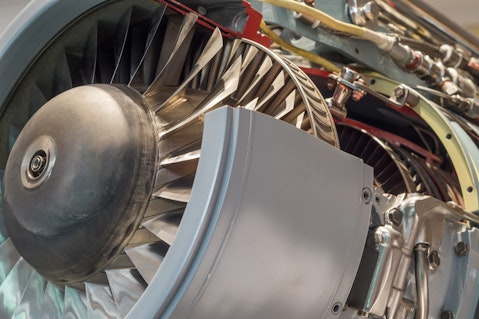
rommma/Shutterstock.com
Airline demand continues to recover as evidenced by nearly 70% increase in 2022 global RPKs versus 21. With China’s new COVID policies expected to accelerate this year-over-year traffic increase, benefiting our third-party MRO operations in particular. The owners is now on the supply chain to ramp aircraft and engine production to satisfy that demand. Increasing demand will enable Triumph to burn down approximately $40 million of past due backlog by the end of fiscal 23. Triumph is producing Boeing 737 components at rates between 30 to 31 per month. Depending on the factory, while Airbus A320, 321 related production levels are 47 to 48 per month. Triumph’s Boeing 737 backlog is up 28% and the A320 backlog is up 12%. Triumph recently received new production forecast from both OEMs, which reaffirm our Q4 deliveries and increase year-over-year deliveries thereafter.
While these forecasts reflected minor adjustments in production profiles, the facts are that rates are headed north, which will benefit all Triumph OEM factories. We’re encouraged by these signals and look forward to providing our fiscal 24 guidance with our fiscal 23 year end results in May. Overall, this is translating into growth for Triumph. Sales for the quarter were up 20% with the OEM sales up 17% and MRO up 24%. The Commercial segment rose 32% and Military 7%. Our year-to-date book to bill is 1.21. Bookings increased 23% year-to-date. On the MRO front, inductions of new parts across our third-party MRO businesses are up 35% for the quarter and 29% year-to-date. Spares and repairs backlog across the entire business, both OEM and third-party MRO are up 36% for the quarter.
Across Triumph backlog is up 12% year-over-year with commercial backlog rising 17%, while military grew 6% aided by programs like the C-130, F-35, Black Hawk, CH-47, Apache and the FAAT. We’re pleased that year-to-date 45% of Triumph’s awards are associated with new products and to our new customers. Competitive wins for the quarter totaling $130 million can be seen on slides 11 and 12. These wins are driven by Triumph IP, on products ranging from airframe mounted gearboxes for the next gen military platforms to landing gear systems for both Sierra space and a leading EV-12 aircraft to a thermal system solution for the General Atomic’s UAV. In the quarter, the fiscal 23 top line defense bill came out reflecting a $75 billion increase year-over-year benefiting key programs in the Triumph portfolio, including the F-15EX, Black Hawk, CH-53E, the B-21, sixth-gen fighters, the KC-46 and the E-2D.
The bill incorporated decreases in the V-22 OEM production from the prior year. However, V-22 is transitioning to an MRO sustainment program for which Triumph maintains significant content and repair volume. We delivered 18 shipsets of V-22 Pylon Conversion Actuators in our third quarter. The recent FMS announcement of 12 CH-47s to Egypt and the U.S. Navy’s decision to approve the CH-53K for full rate production, our welcome news as Triumph provides and maintain significant content on these platforms, including instant fuel controls, fuel pumps actuation and heat exchangers. Triumph has also got content on the recently revealed B-21 bomber and is pursuing work share across the sixth-generation fighters in early development. Our path to value through exiting lower margin build-to-print work in favor of proprietary and sole source positions across ramping and new start programs is reflected in the new wins on new platforms.
Turning to slide 13, Triumph is bringing new capabilities to the market. These include fuel pumps and actuators for GE’s new military adaptive cycle engine, a new high-capacity vapor cycle cooling system for next gen military platforms and the complete landing gear system for both the Sikorsky RAIDER and the RAIDER X vehicles, as well as the Sierra Nevada Dream Chaser Space Vehicle. We are working to implement additive solutions across all these product lines. Partnerships have been a key enabler to our MRO growth, our JV with Air France for nacelle repairs on newer aircraft and our planned JV in the Middle East with Mubadala and Sanad will provide access to the region’s MRO markets and enable us to accelerate growth in engine accessory repairs.
Taken together, our growing backlog and improving mix of OEM and aftermarket business keeps us on track to be cash positive in the second half of fiscal 23 and beyond. And to raise our guidance for the full-year. As a board and management team, we look forward to improving markets and stronger financial performance and to renewing our capital structure in support of our growth. Jim and I are happy to take any questions you have.
See also 20 Biggest Companies in Ohio and 25 Biggest California Companies.
Q&A Session
Follow Triumph Group Inc (NYSE:TGI)
Follow Triumph Group Inc (NYSE:TGI)
Operator: We will now begin the question-and-answer session. Our first question will come from Seth Seifman with JPMorgan. You may now go ahead.
Seth Seifman: Hey, thanks very much and good morning, everyone. I wonder if you could talk a little bit about the structures business. And the profitability there in the quarter, I think the core interiors piece, I think we talked last quarter about being about breakeven and then there were some closeouts related to 747. Should we think about this level of sales and profitability with kind of low-teens margin as being the go-forward margin from here for the core interiors business? Or was there some lingering goodness from the 747 in the December quarter as well?
Jim McCabe: Yes. Thanks, Seth. I’ll start, it’s Jim. Before the pandemic that was a 20% business and it still has the potential to go there again. It got hurt by the MAX, but the MAX is recovering now. So actually last quarter, it was modestly profitable and cash positive. So going forward, it’s just going to grow from there. And you got hurt a little bit by the 787, but when that comes back, that’s going to help even more. So it’s a very good business. It is a continuing operating business in there. It is profitable and cash positive now and it can get back up to 20% margins.
Seth Seifman: Right. Okay. But when we’re thinking about sort of Q4 here, that kind of — that’s kind of like a 10% to 155 margin business now in interiors?
Jim McCabe: Not yet. It’s ramping. It’s in the single-digit margins now. But it will ramp further as MAX continues to help it out with extra volume and as 787 comes back, we actually finished the consolidation of our Spokane facility operations into there. So we’re starting to see the benefit from the cost reductions there as well. So no, it’s not in the teens yet.
Dan Crowley: But on a full-year basis, but quarterly, it’s in that range that you described, because it’s on a very steep slow.
Seth Seifman: Okay, okay. Thanks. And then just the strong MRO growth in the S&S business, thinking about the difference there between, kind of, product related growth and your repair related growth. How would you characterize any differences between those two markets right now?
Dan Crowley: Right now they’re both on the upswing. When you look at the OEM rates like Airbus, they delivered — they’re delivering about 45 a month on the narrow body, but they’re headed to 58 at year-end with similar increases out of Airbus and we’re also on the A220 that’s going up from about seven a month to 10 a month of India. So we’re seeing strong OEM rates, but what’s leading us out of the pandemic is the MRO growth. I mentioned the increase in induction, so we stand there and watch for parts coming in from the engine side. We do overhauls of gear boxes, engine accessories. And then the cells, thrust reversers, structural repair, even some interiors MRO, it’s all going up. And this is a reflection just how much volume the carriers have.
I mean, American had their highest full-year revenue in the company’s history in 22. Delta had revenue that was higher in Q3, Q4 than 2019. And you read about United’s big orders for 787 and 737 MAX, as well as Southwest. They also surpassed 2019 levels. And they’re all triggering new orders. So in the short-term, the demand for MRO for both the legacy fleet, which they’re keeping in operation till the new aircraft arrive and then their newer fleet is quite high. So that’s been a big tailwind for us, because the MRO space has shorter cash payments and cash to cash and it’s also profitable.
Seth Seifman: Great. Thank you very much.
Dan Crowley: Thanks, Seth.
Operator: Our next question will come from Peter Arment with Baird. You may now go ahead.
Peter Arment: Yes, thanks. Good morning, Dan and Jim. Hey Dan, you mentioned positive free cash flow thinking about that, you know, not only for the fourth quarter, but fiscal 24. Jim, I wonder if you could just maybe I know you’re going to give us more detailed guidance on that in May, but just kind of some of the bigger moving pieces that are going to improve, like when we think about working capital this year, which is a big drain, just some of the key pieces that you’re looking at? Thanks.
Jim McCabe: Sure. So first, only cash use this quarter was $5 million and it’s really to fund the growth in the fourth quarter, which is above what we expected. And in fourth quarter, if you look at the midpoint of the range, I think you’re in the $60 million cash generation roughly in Q4. So it’s nice solid finish and good trends going into next year. So for next year, obviously, the volume that we’re seeing and the growth in both MRO and OEM is contributing to the cash positive next year. And the absence of one-timers, we did exit some businesses that were working capital users earlier in the year and maybe not as profitable as the rest of the business. So we’ve improved the portfolio. We’ve reduced our costs. We talked about rationalizing some of the SG&A overhead with the smaller business. Those are the key drivers. But as you said, and look forward to give you a lot more specifics when we give guidance next quarter.
Peter Arment: Okay. And just as a follow-up, Dan, it’s great to see the structures business turn up and obviously you talked about an improving run rate there and a steep run rate. Is this business still considered core just given how you’ve reshaped the systems business for the long-term? Just having a lot of aftermarket and related IP versus this business? Maybe you could just describe it how it fits into the portfolio? Thanks.
Dan Crowley: You bet. There is certainly customer synergies. In the last year, interiors booked about $1 billion of backlog that’s going to keep them in business for 10-years without the need to win a lot. Our new work and yet they’re still winning. I mentioned the A220, they’ve got key interiors work on that now. So it’s contributing to us financially. It has an absorption benefit. One of our better operations in Mexico. They do a great job with their lean performance. There’s not a lot of product synergies in the sense that we bundle interior solutions with systems. So in that sense, there’s not a big connection. But it is an important business to us. I will say, we look at every one of our businesses every year in terms of its trajectory and contribution to Triumph and how fast we can grow it and make that decision about whether we retain it or manage it for cash.
Right now it’s about re-ramping that interiors business to the level of sales and profit they’ve had in the past and we’re confident we can do it.
